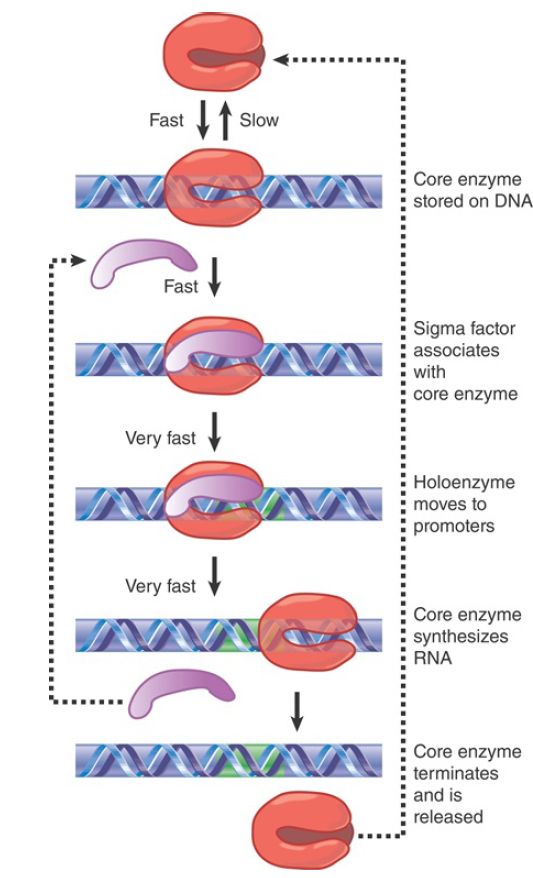
Interactions Between Sigma Factor and Core RNA Polymerase Change During Promoter Escape
 المؤلف:
JOCELYN E. KREBS, ELLIOTT S. GOLDSTEIN and STEPHEN T. KILPATRICK
المؤلف:
JOCELYN E. KREBS, ELLIOTT S. GOLDSTEIN and STEPHEN T. KILPATRICK
 المصدر:
LEWIN’S GENES XII
المصدر:
LEWIN’S GENES XII
 الجزء والصفحة:
الجزء والصفحة:
 4-5-2021
4-5-2021
 2222
2222
Interactions Between Sigma Factor and Core RNA Polymerase Change During Promoter Escape
KEY CONCEPTS
- A domain in sigma occupies the RNA exit channel and must be displaced to accommodate RNA synthesis.
- Initiation describes the synthesis of the first nucleotide bonds in RNA.
- Abortive initiations usually occur before the enzyme forms a true elongation complex.
- Sigma factor is usually released from RNA polymerase by the time the nascent RNA chain reaches approximately 10 nucleotides in length.
RNA polymerase encounters a dilemma in reconciling its needs for initiation with those for elongation. First, the RNA exit channel is actually occupied by part of the sigma factor, the linker connecting domains 3 and 4. Therefore, promoter escape must involve rearrangement of the sigma factor, displacing it from the RNA exit channel so that RNA synthesis can proceed. Second, initiation requires tight binding only to particular sequences (promoters), whereas elongation requires association with all sequences that the enzyme encounters during transcription. FIGURE 1 illustrates how the dilemma is solved by the reversible association of sigma factor with core enzyme.

FIGURE 1. Sigma factor and core enzyme recycle at different points in transcription.
Initiation involves the binding of the first two nucleotides and the formation of a phosphodiester bond between them. This generates a ternary complex containing RNA as well as DNA. At most promoters, an RNA chain forms that is several bases long and could be up to 9 bases long without movement of the polymerase down the template. The initiation phase is protracted by the occurrence of abortive events in which the enzyme makes short transcripts, releases them, and then starts synthesis of RNA again. The initiation stage ends when the polymerase succeeds in extending the chain and clears the promoter.
As mentioned above, the enzyme usually undergoes cycles of abortive initiation in the process of escaping from the promoter. The enzyme does not move down the template while it undergoes these abortive cycles. Rather, it pulls the first few nucleotides of downstream DNA into itself, extruding these single strands onto the surface of the enzyme in a process called DNA scrunching. By a mechanism that is not completely understood, the enzyme then escapes from this abortive cycling mode and enters the elongation phase .
Although the release of sigma factor from the complex is not essential for promoter escape, dissociation of sigma factor from core usually occurs concurrently with or soon after promoter
escape. Sigma factor is in excess of core RNA polymerase, so release of sigma from holoenzyme is not simply to make it available for use in additional copies of holoenzyme. In fact, sigma factors compete for limiting copies of core RNA polymerase as a means of changing the transcription profile (see the discussion of multiple sigma factors later in this chapter in the section titled Competition for Sigma Factors Can Regulate Initiation).
The core enzyme in the ternary complex (which comprises DNA, nascent RNA, and RNA polymerase) is essentially “locked in” until elongation has been completed. As will be described shortly, this processivity results in part from the way the enzyme encircles the DNA and in part from the increase in the affinity of the enzyme forthe compl ex afforded by interactions with the nascent RNA. The drug rifampicin (a member of the rifamycin antibiotic family) blocks transcription by bacterial RNA polymerase. It is the major antibiotic used against tuberculosis. The crystal structure of RNA polymerase bound to rifampicin explains its action: It binds in a pocket of the β subunit, less than 12 Å away from the active site, but in a position where it blocks the path of the elongating RNA. By preventing the RNA chain from extending beyond two to three nucleotides, it blocks transcription.
 الاكثر قراءة في مواضيع عامة في الاحياء الجزيئي
الاكثر قراءة في مواضيع عامة في الاحياء الجزيئي
 اخر الاخبار
اخر الاخبار
اخبار العتبة العباسية المقدسة


